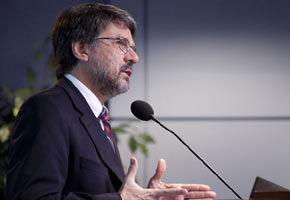

For FAPESP Scientific Director Carlos Henrique de Brito Cruz, "there is still plenty of room for collaboration on projects and for increasing the impact of science produced in Brazil" (photo:JVInfante Photography/Wilson Center)
For FAPESP Scientific Director Carlos Henrique de Brito Cruz, “there is still plenty of room for collaboration on projects and for increasing the impact of science produced in Brazil.”
For FAPESP Scientific Director Carlos Henrique de Brito Cruz, “there is still plenty of room for collaboration on projects and for increasing the impact of science produced in Brazil.”

For FAPESP Scientific Director Carlos Henrique de Brito Cruz, "there is still plenty of room for collaboration on projects and for increasing the impact of science produced in Brazil" (photo:JVInfante Photography/Wilson Center)
Agência FAPESP – The main objective of FAPESP Week is the increased visibility of Brazilian science achieved by Brazilian scientists communicating to their colleagues the results of advanced research conducted in Brazil. The symposium is being held at the Woodrow Wilson International Center for Scholars in Washington, DC October 24-26.
For FAPESP Scientific Director Carlos Henrique de Brito Cruz, “there is still plenty of room for collaboration on projects and for increasing the impact of science produced in Brazil.” In his presentation, Brito Cruz highlighted the sustained growth in the number of articles published by Brazilian researchers over the past 30 years as well as the training of human resources.
“Of the 12,000 doctors who graduate in Brazil every year, 2,200 receive this degree at USP, 800 at Unicamp and 800 at UNESP.” This capacity points to the main challenges currently facing Brazilian science: increase the impact these scientists have on scientific production, which translates into the number of citations of their published articles, expand international cooperation, and increase the number of researchers working at universities and research institutes as well as in companies.
Brito Cruz emphasized projects in basic research focused on application as well as on providing opportunities for foreign researchers in the foundation’s research programs and other initiatives. Among these initiatives is the SP – Excellence Chair to be announced at the end of November, with calls for proposals scheduled for the first half of 2012. This program will support projects proposed by “first class scientists” of any nationality who agree to advise postdoctoral researchers, the coming of visiting researcher from their country of origin, and the purchase of equipment. In total, the selected projects may receive up to 2 million reais.
The Director also mentioned some examples of the type of research that proposes important challenges and may involve collaboration between Brazilian and foreign scientists. Research projects in molecular biology conducted under FAPESP’s Bioenergy Research Program (BIONE), for example, could potentially increase sugarcane productivity from 84 tons/hectare to 280 tons/hectare, and the FAPESP Research Program on Global Climate Change (RPGCC) is developing the Brazilian Climate Model – a contribution needed in order to understand the role Brazil’s climate plays in changes that are taking placed on the planet.
The Biota-FAPESP Program that describes the biodiversity in São Paulo and in Brazil, defined mechanisms for conservation and sustainable use that may be significantly extended in cooperation among researchers. Nearly 20 government decisions were already implemented, such as agro-environmental zoning for the state’s sugar-alcohol industry and the drafting of a Regulatory Act that establishes priorities for action by the Office of the State Public Prosecutor with regard to identification and censure of activities that cause environmental degradation in São Paulo
Republish
The Agency FAPESP licenses news via Creative Commons (CC-BY-NC-ND) so that they can be republished free of charge and in a simple way by other digital or printed vehicles. Agência FAPESP must be credited as the source of the content being republished and the name of the reporter (if any) must be attributed. Using the HMTL button below allows compliance with these rules, detailed in Digital Republishing Policy FAPESP.





